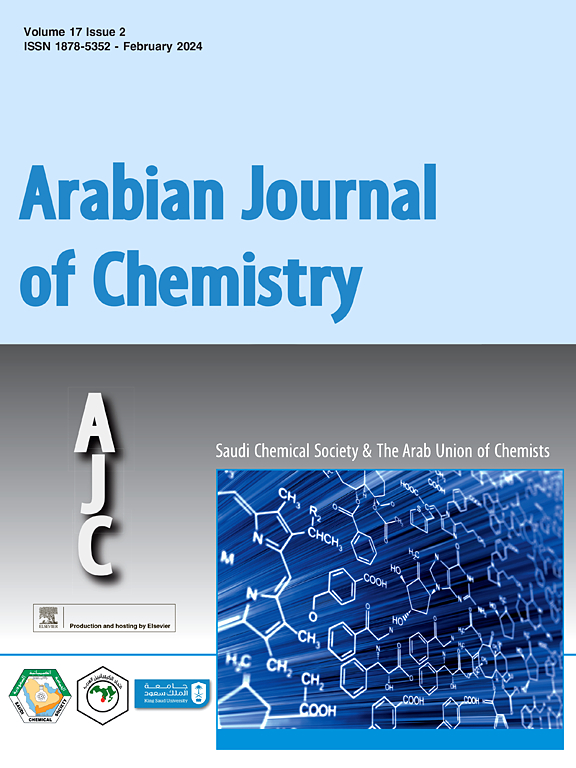Biological evaluation of sophoridine by interaction with plasma transport protein and protective effects in cardiomyocytes
IF 5.2
2区 化学
Q2 CHEMISTRY, MULTIDISCIPLINARY
引用次数: 0
Abstract
Numerous studies have demonstrated the protective benefits of sophoridine, a bioactive alkaloid, on cell damage. However, its primary biological properties such as interaction with plasma protein, which serves as the primary drug carrier, and its cardioprotective properties are still unknown. In the present study, we aimed to analyze the binding characteristics of sophoridine with alpha-2-macroglobulin (α2M) by spectroscopic and theoretical studies. Then, the cardioprotective effects of sophoridine on myocardial ischemia/reperfusion (MI/R) injury in vitro were investigated using H9c2 cardiomyocytes. The results reveal that one molecule of sophoridine favorably binds to one molecule of α2M dominantly through interaction with hydrophobic amino acid residues (VAL758, PHE735, PHE735, and TRP739). Also, sophoridine leads to partial changes in the structure of this carrier protein in the vicinity of TRP739 residue. Cellular assays exhibit that sophoridine recovered cell viability, membrane leakage, and apoptosis induced by MI/R injury. It was detected that sophoridine could mitigate the oxidative stress and intrinsic apoptosis pathway through regulation of Bax, Bcl-2, and caspase. ELISA analysis also exhibits that sophoridine upregulates phosphorylation of Akt and PI3K in H9c2 cells. Our findings suggest that sophoridine could show favorable plasma protein interaction and promising cardioprotection against MI/R injury mediated by the upregulation of PI3K/AKT signaling pathway.
槐定碱与血浆转运蛋白的相互作用及对心肌细胞的保护作用的生物学评价
大量研究表明,槐定碱是一种生物活性生物碱,对细胞损伤具有保护作用。然而,槐定碱的主要生物学特性,如与作为主要药物载体的血浆蛋白之间的相互作用,以及它的心脏保护特性仍然未知。在本研究中,我们旨在通过光谱和理论研究分析槐定碱与α-2-巨球蛋白(α2M)的结合特性。然后,利用 H9c2 心肌细胞研究了槐定碱对体外心肌缺血再灌注(MI/R)损伤的心脏保护作用。结果发现,一分子槐定苷主要通过与疏水氨基酸残基(VAL758、PHE735、PHE735 和 TRP739)的相互作用与一分子 α2M有利地结合。此外,槐苷还会导致 TRP739 残基附近的载体蛋白结构发生部分变化。细胞实验表明,槐定碱可恢复细胞活力、膜渗漏和 MI/R 损伤诱导的细胞凋亡。研究发现,槐定碱可通过调节 Bax、Bcl-2 和 caspase 来减轻氧化应激和细胞凋亡的内在途径。ELISA 分析还显示,槐定碱可上调 H9c2 细胞中 Akt 和 PI3K 的磷酸化。我们的研究结果表明,槐定碱可通过上调 PI3K/AKT 信号通路,与血浆蛋白发生良好的相互作用,并有望对 MI/R 损伤起到保护心脏的作用。
本文章由计算机程序翻译,如有差异,请以英文原文为准。
求助全文
约1分钟内获得全文
求助全文
来源期刊

Arabian Journal of Chemistry
CHEMISTRY, MULTIDISCIPLINARY-
CiteScore
10.80
自引率
3.30%
发文量
763
审稿时长
63 days
期刊介绍:
The Arabian Journal of Chemistry is an English language, peer-reviewed scholarly publication in the area of chemistry. The Arabian Journal of Chemistry publishes original papers, reviews and short reports on, but not limited to: inorganic, physical, organic, analytical and biochemistry.
The Arabian Journal of Chemistry is issued by the Arab Union of Chemists and is published by King Saud University together with the Saudi Chemical Society in collaboration with Elsevier and is edited by an international group of eminent researchers.
 求助内容:
求助内容: 应助结果提醒方式:
应助结果提醒方式:


